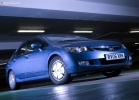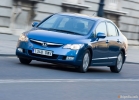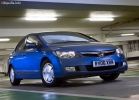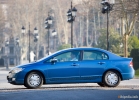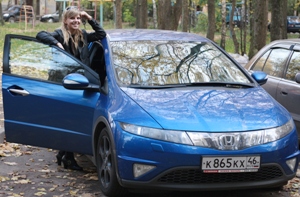Test drive Honda Civic sedan 2006 - 2008 sedan
Talent of communication
The new generation Honda Civic will debut in the Russian market as a sedan with a 140-horsepower engine. The new car demonstrated at the modern level all those family features, thanks to which the name Civic once gained its fame.I do not wear any cylinders or pots. I am not a gentleman and, therefore, I can quite afford to get into the car, and not go into it. And my height slightly exceeds eighty meters. Perhaps only because of these unique features I do not feel much enthusiasm for the total golf class of golf classes to catch up the trunk buses. The new Honda Civic, for nothing that we are talking about a sedan with an automaton, a centimeter below (!) The previous generation machines. Today it is almost unbelievable. But even despite the fact that the chances of becoming an official car of the national team of basketball players at Honda Civic, the car makes the most pleasant impression.
Over the past twenty years, adherents of a formal approach to evaluating the class belonging of cars have been trying to prove to the world that by the name Honda Civic it is certainly necessary to mean a high -quality, but ordinary little Japanese woman. They are trying to prove this with the help of such blind arguments as the ratio between the number of cars sold in utilitarian versions and the number of various, in their opinion, renegades such as Type R, VTI, Si, CRX, del SOL (depending on the era and the continent). However, this statement is not at all true. From the engineering, aesthetic and emotional point of view, Honda Civic of utilitarian versions, unlike the vast majority of classmates, are the shadows of celestials that descended to everyday life. It is not the other way around, as it happens in the automotive world more often. Even the modest versions of the car have had an independent two-winged suspension since 1989, and the system for changing the phase distribution phases since 1991 ...
Charisma of the car was initially emotional and quickly preserved today. It is felt even in the appearance of a car with a sedan body: wow, new! And how much strength is there? Probably 200?
It is this monologue that the talkative passers -by those who were delayed near the car are exhausted, being under the influence of the laconic language of the harmony of clean lines of the Honda Civic body.
The engine is still one: an aluminum power unit with a working volume of 1.8 liters and a capacity of 140 hp. Like all Honda engines, it is 16-clapable. With one distribution shaft and I -VTEC system.
The proprietary system is modernized in order to improve fuel efficiency with low engine loads. In a stable mode of low-speed driving (10003500 RPM), I-VTEC holds one of the intake valves open at the beginning of the compression tact, reducing the locked volume and, as a result, loss of compression when working with low loads. In addition, due to the ability to operate with phases of opening inlet valves, in cruise modes, engineers managed to use the effect of artificial anti -pressure in the intake path to reduce the volume of the combustible mixture that is acting in cylinders. At the same time, the throttle is open quite widely: traction controls no longer requires the driver of millimeter movements with the right foot. The I-VTEC has a inlet collector with two channels for each cylinder: up to 5200 RPM is involved only in a long tunnel, and with further promotion, a shorter channel is additionally opened.
Despite the fact that the gas drive is electronic, Civic bribes both the responsiveness and accuracy in its responses to the pedal and the materiality of the driver’s sensations: there is no longer the impression that you dispose of the dynamics with the help of a ship telegraph, as it was when using the first electronic systems. The new Hondovsky five -speed machine debuts on this machine: a solid modern automatic transmission with a hydrotransformer. A pleasant circumstance is that the manual mode here is honest: you want to hang on a limiter (by the way, it is harsh). If you want to brake engine, the benefit of using the petals on the steering wheel.
Around the steering wheel, the area of \u200b\u200bmagnificent driver's ergonomics is concentrated. Planting in a wide seat with moderate lateral support vividly resembles the one that was characteristic of the Civic of the fifth and sixth generations: the legs are largely extended parallel to the floor, the recreation site and the floor gas pedal are almost vertically. The position of an extremely convenient steering wheel of a small diameter is adjustable both in height and in departure. Right in front of the driver’s eyes there is a large saucer of a tachometer, just above the digital speedometer: not the most traditional instrument layout, but it is read perfectly. Only blue backlight causes certain fears.
Another, as far as unusual, is the same successful decision to place a hand brake lever. And how insignificant the distances from it to the steering wheel to the steering wheel (or handles of mechanics) are reminded of a purely racing approach to saving the driver’s body movements required. Verser switches, mirror control buttons are made large, relief and allow you to immediately rely on tactile sensations, without distracting attention from the road. The visibility of the forward is quite good, except that traditionally for most modern cars is spoiled by the wide left front counter. The last touch to the picture of caring for the driver is that even the handle of the opening of the castle of the glove box (very small) is oriented in his direction.
The space for the rear passengers does not shine with special abilities: it is quite decent that you can get settled only behind a person of medium height. If the front seats are significantly pushed away, there are very few places for the knees.
The luggage compartment has an ordinary capacity (c. 340 l), but it is convenient to use due to the low loading height, clean internal shape and the ease of folding the back of the rear seat (in parts).
Passengers may complain that the car is noisy. Indeed, there was never a serious sound insulation in Civic as never. It is hardly the matter of saving funds: the interior is finished at the level of golf class leaders. This can be perceived as a tradition. And if you are driving, you are unlikely to be able to pick up the noise. Even though the Honda engines had more thoroughbred voices.
You will not be up to the sounds of a bad mood: the chassis works so well that it even turns a simple city trip into pleasure. The components of this success are the family roots of the controllability settings and the front suspension castor is exceptional to the front -wheel drive. As well as a successful adjustment of the rear suspension, an honest hydraulic wrap and a short steering rack (2.67 turnover). The winning combinations and the ratios between the honed controllability, lightning and accurate feedback on the steering wheel while maintaining an acceptable level of comfort and the presented horses adequate to Russian roads introduce the current Honda Civic into a narrow circle of mass cars with a first -class chassis. Will there be a hatch?
Russian buyers will learn this only in the summer. And the Honda Civic sedan can be bought today. Prices for a car with an automaton start with $ 21,200.
+ Quality, handling, ergonomics.
Noise insulation.
Technical characteristics of Honda Civic
Sedan body
Equipped mass, kg 1220
Full mass, kg 1620
Dimensions, mm:
- length 4490
- Width 1750
- Height 1435
Base, mm 2700
Trunk volume, l 340
Maximum speed, km/h 190
Acceleration time to 100 km/h, from 9.5
Control consumption of fuel, l/100km 7
Engine:
-type of gasoline, in-line, 4-cylinder, 16-valve, Sohc i-VTEC
- working volume, cm3 1798
- Power, L.S. at MIN-1 140/6300
- torque, NM at min-1 174/4300
The transmission is automatic, 5 -t.
Wheel suspension (front/rear) mcpherson
Brakes (front/rear) disk., Ventil./Disk.
Price, $ from 21,200
Text: Dmitry Sokolov
Source: Magazine 5 wheel [05/2006]
Honda Civic Crash Test Video Sedan 2006 - 2008
Honda Civic Sedan 2006 test drives - 2008
Honda Civic Crash Test Sedan 2006 - 2008
Krassh Test: Detailed Information31%
Driver and passengers
21%
Pedestrians
38%
Children-passengers

